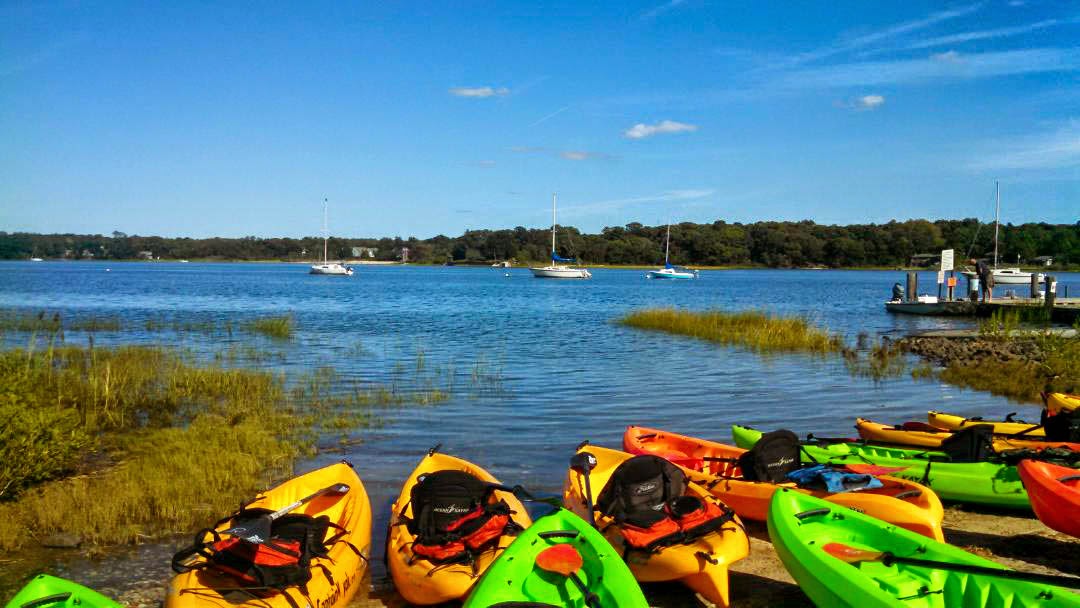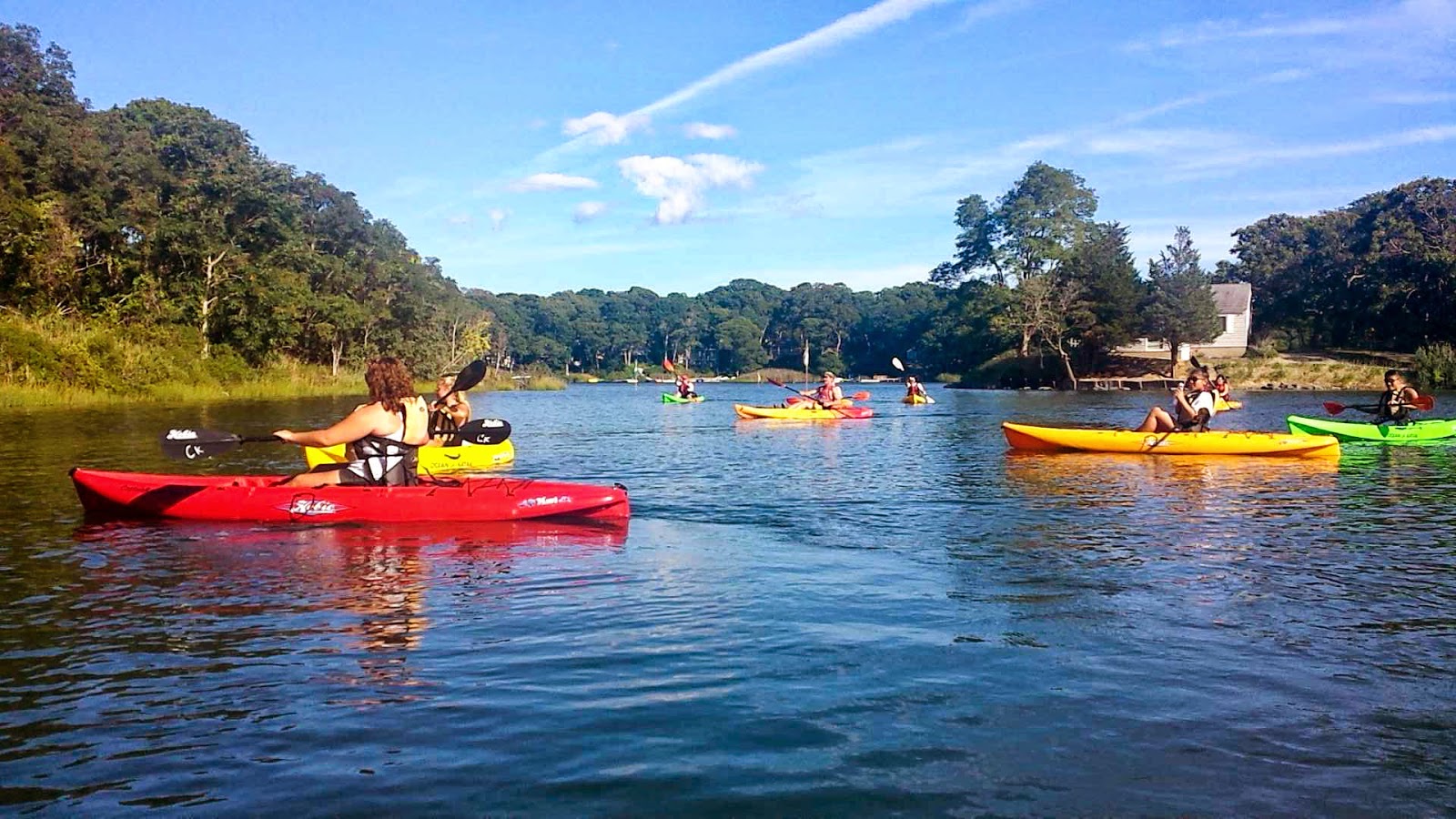Kayak Trip
by Meaghan Coyne
What an amazing day we had this week in Coastal Cultural Experiences! We started our day kayaking in local Southampton waters. Some of us are experienced kayakers and some of us had never been before. Regardless, within about five minutes everyone was paddling with no problem. We were out on the water in the kayaks for about an hour and a half. We stopped twice to listen to mini lectures from our professors Tara and Kurt about the historical and environmental aspects of the area we were kayaking through and then proceeded to end our kayak trip on the beach.
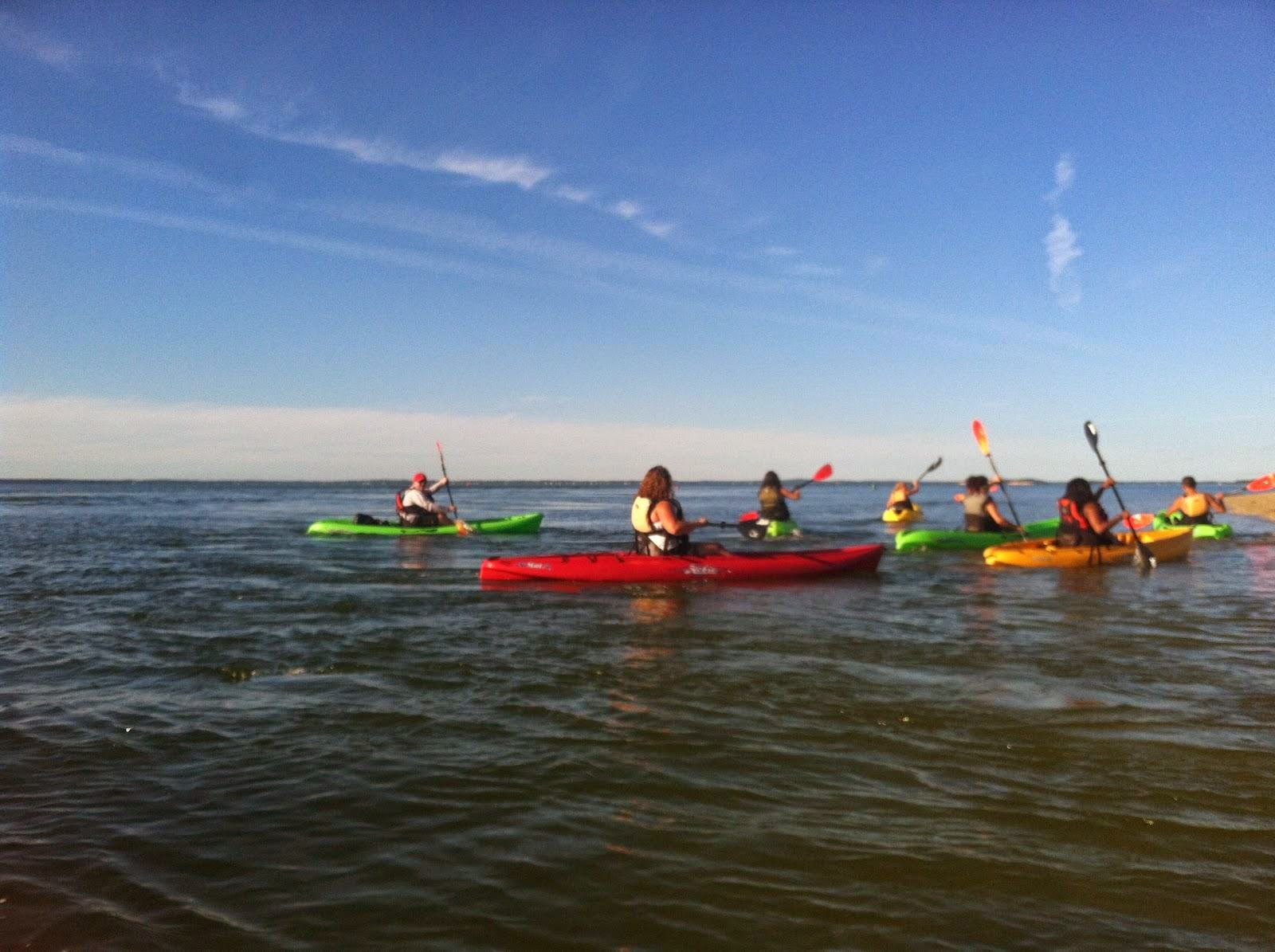 |
| This was taken at the beginning of our trip. Here you see about half the class enjoying the warm weather and getting used to kayaking. |
Once we got to the beach we were greeted by other lovely SoMAS employees, Andy, Courtney, and Brandon, who had prepared a delicious meal for us. There was so much food we had our choice of about every single fish in the sea to choose from for dinner and then tasty brownies made by Tara for dessert. I think everyone went home with a full stomach.
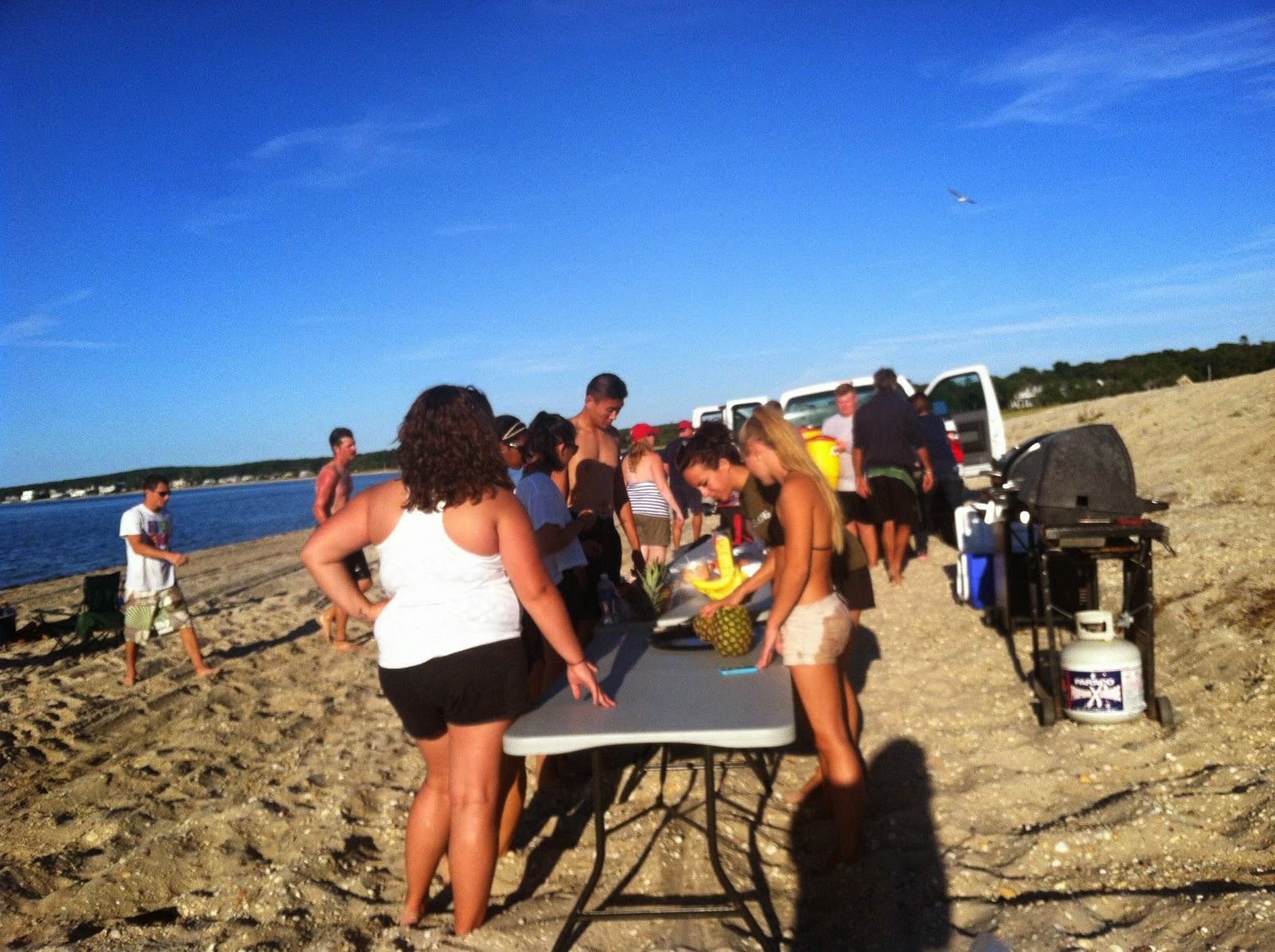 |
| All of us were starving after kayaking for so long! As soon we got to the beach all of us ran to the food table. Many of us pitched in preparing the meal whether it was by catching the fish that we ate (Riley) or by cutting the pineapple (Valerie and Libby). Thanks to Andy for cooking! |
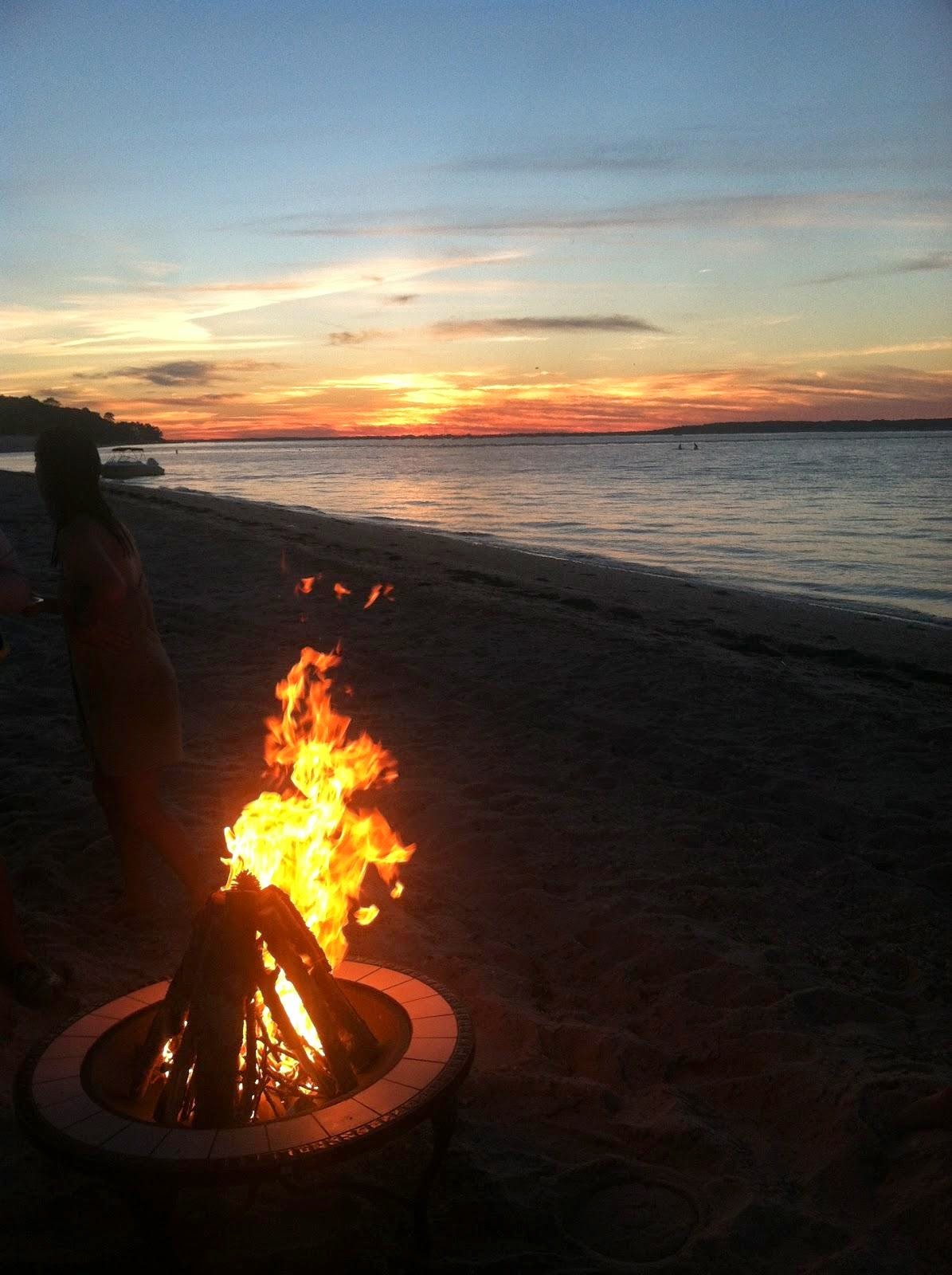 |
| What’s better than a gorgeous sunset? A gorgeous sunset with a bonfire. What better than a gorgeous sunset with a bonfire? A gorgeous sunset and a bonfire at the beach. |
As it got darker we all congregated on the beach and sat around a bonfire that Kurt had made. After talking for a bit the conversation (as one would expect with a group of Marine Biology Students) turned to maritime topics, and specifically, sea shanty songs. A shanty is a sung song by deckhands working on large vessels. These songs were sung for a couple of reasons. One, there is little entertainment on boats, you can’t watch TV or play games on your phone so many fisherman turn to music. Singing is an easy way to have fun and build a community with everyone on the boat. Two, songs have a beat. If two men are pulling in a rope together they need to be doing so at the same rhythm. If they’re pulling at different times they’re going to be a lot less efficient. However, if both of them are singing a song together they’ll both be pulling to the same beat.
Two of our fellow classmates, Rob and Val, know a couple of shanties so they taught us one. The way it works is that everyone sings the first verse and then each person gets a turn to make up their own verse by altering the first line. The song repeats until everyone has gone. Here’s the first verse:
A drop of Nelsons blood won’t do us any harm
A drop of Nelsons blood won’t do us any harm
A drop of Nelsons blood won’t do us any harm
And we’ll all fall in behind
We’ll roll the old chariot along
We’ll roll the old chariot along
We’ll roll the old chariot along
And we’ll all fall in behind
Some examples of verses we made up were “A 4.0 GPA won’t do us any harm” and “A Semester by the Sea won’t do us any harm”.
 |
| All of us warming up around the bonfire. Here, Tara and Rob are explaining shanties to the rest of us. |
The Perfect Day: Kayaking our way through History
by Jeanne Chang
Sunny, with a high of 76 oF, it was the perfect day to kayak in the Peconic Bay! Even though this was for class, it felt more like a vacation with fun friends and interesting tidbits from our parents. As we met at the vans in the early afternoon, our professors (parents) Kurt and Tara scurried us along into our seats after making sure we had full water bottles, sunscreen, and gone to the bathroom. We drove to the North Sea Harbor and parked the vans where two friendly faces greeted us with bright orange and lime green kayaks. After a brief safety talk, everyone raced to pick a kayak, and with the help of a few gentle shoves into the water, we were paddling happily into the Harbor!
Figure 1: Here is the array of kayaks before launching them into North Sea Harbor. These are sit on top ocean kayaks. One for each of us!
As everyone started to get their bearings, we kayaked under a bridge and through an inlet into Fish Cove, where the water path narrows and houses on either side peak out through the treeline. As we noticed that the habitat along the water’s edges were salt marshes, classmates started yelling out, “Spartina alterniflora! Distichlis! Iva!”making Kurt proud, we’re sure. As we neared a pole in the water, Kurt herded us together to take pictures and lecture about the importance of forage fishes.
Key examples of forage fishes in this area are the Atlantic silverside and the anchovy. Forage fishes not only provide services to the ecosystem and predator fishes, but they also are a major food source for migratory birds and marine mammals. Globally, they also provide economic importance as forage fish fisheries and therein-economic value with predator fishes (Pikitch et al. 2014). We talked about how the biggest causes of decline in forage fishes on the east coast are dams. Often times, these dams do not serve a practical purpose anymore and only cause further habitat destruction and hindrance to water flow along streams and rivers (forage fish homes).
Figure 2: The class kayaking near Fish Cove. The edge of the water is surrounded by salt marsh plants, which is often good habitat for forage fishes. We all remembered how to identify the grasses too!
After our short talk, we kayaked back under the bridge and into North Sea Harbor again, we made our way to Conscience Point, where we paddled into the marshes and had another photo shoot. In order to do this, Kurt beached his kayak and climbed on top of a rock, a tribute to Conscience Point. Tara reminded us all that at this point in 1640, the first woman in stepped on to land, and remained there to settle Southampton for the first time.
As we made our way back out of the marshes, we paddled up the creeks (with a paddle), and found that we were just west of Scallop Pond, where the Long Island Marine Habitats lab recently sampled. As we kayaked along the marshes, we saw a few egrets wading in the water and gliding across the treeline. The forests along the edges of the water are federally protected. However, the watery intertidal zone is a bit trickier to understand. Kurt and Tara briefly touched on the importance of protecting these waters and lands to preserve the beauty and biodiversity of the area, in addition to continued public use over time. The intertidal zone is a public resource, protected under the Public Trust Doctrine, which dates back to the English monarchy, according to the Natural Resources Protective Agency (NRPA). The doctrine essentially says that no single person can own these intertidal waterways, lands, and public resources. In 1641 and 1647, as the colonists got settled in New England and Southampton and resource regulation became increasingly important, the English monarchy affirmed changes to common law and the Public Trust Doctrine. Essentially, it stated that it is the government’s duty to protect and preserve the common resources, such as the waterways and wildlife. In recent years, the use of the Public Trust Doctrine has been debated in cases where private entities and political agendas may try to swing regulations certain ways under the guise of common law.
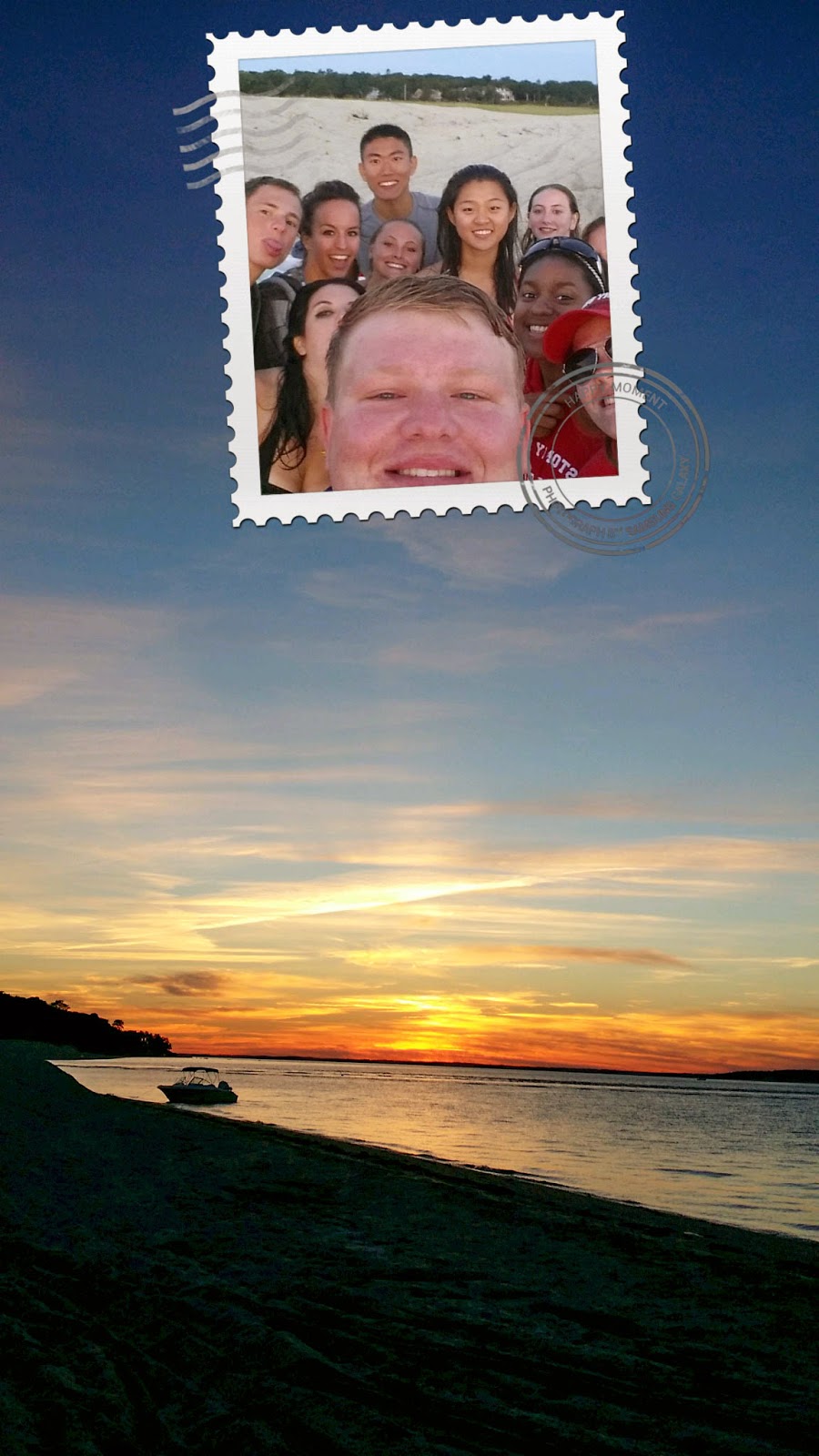 |
|
Figure 3: This is a picture of the class at sunset. After feasting and swimming, we were excited to start the bon fire! Thanks to Val and Rob, we learned a new Sea Shanty. A pretty little sunset wouldn’t do us any harm…
|
After we paddled out of the creek, we headed out of North Sea Harbor and into Little Peconic Bay. We kayaked along the beach and met the gentlemen who helped us launch our kayaks initially where they helped us carry our kayaks out of the water. After all of our kayaks were brought up to the beach, we were greeted with a wonderful site: tables and grills full of food and drinks! The rest of the trip we ate various freshly caught fish, such as the mighty Bluefish that our classmate Riley caught earlier that morning, delicious clams and a wonderful array of vegetables and fruit. It was restaurant grade food, and it was all for us. We definitely got our daily doses of delicious nutrition. We ate great food, swam in the bay, watch the brilliant sunset by bonfire, and then sang a few sea shanties by twilight. It was a wonderful day of class kayaking through history.
Works Cited
(NRPA) Natural Resources Protective Association. Public trust doctrine. http://www.nrpa.com/resources/public-trust-doctrine/.
Pikitch, E., K. J. Rountos, et al. The global contribution of forage fish to marine fisheries and ecosystems. Fish and Fisheries. 15:43-64. http://onlinelibrary.wiley.com/store/10.1111/faf.12004/asset/faf12004.pdf;jsessionid=F6E17B61A636319C6142FE808A513E84.f02t01?v=1&t=i02oegii&s=b4d0723be03e73f9c8cdbe10f85393ab6337e238.
Kayak Trip & Food from the Sea
by Carlin Yu
We could not have wished for a better weather than it was today for a trip like this. The warm weather and bright sun made it an enjoyable day to go kayaking and have a cook out on the beach. Professor Kurt said that we are very lucky to have such a wonderful weather because the previous year had a hard time scheduling a kayak trip due to bad weather. We took the vans and went to North Sea Harbor to go kayaking. This trip was not only fun but educational. Professors Kurt and Tara relayed to us information about the area around us, the area’s history and species that were around. This was a great outdoor learning experience.
 |
| Professor Kurt giving a mini lecture at Conscience Point. This was the point where a woman demanded to get off the boat after being on the boat for a few months. Afterwards she refused to get back on the boat and so this is when the first settlement in Southampton begin. |
After a few hours of kayaking and learning, we went to a beach where our Southampton faculty and grad students was preparing for our cook out. It may seem as though our learning for the day was over but this isn’t true. Whenever we see something we learned in one of the many marine classes such as Ichthyology and Long Island Marine Habitat, we would quickly give each other a pop quiz on it. When we saw the scallops come out of the grill, we quickly quiz each other on how we can tell if it is a real scallop or not. If it is a real scallop, the muscles are not striated. Fake scallop are striated because they meat from a shark’s fin. It is a great way to study and a great way to help each other know the material.
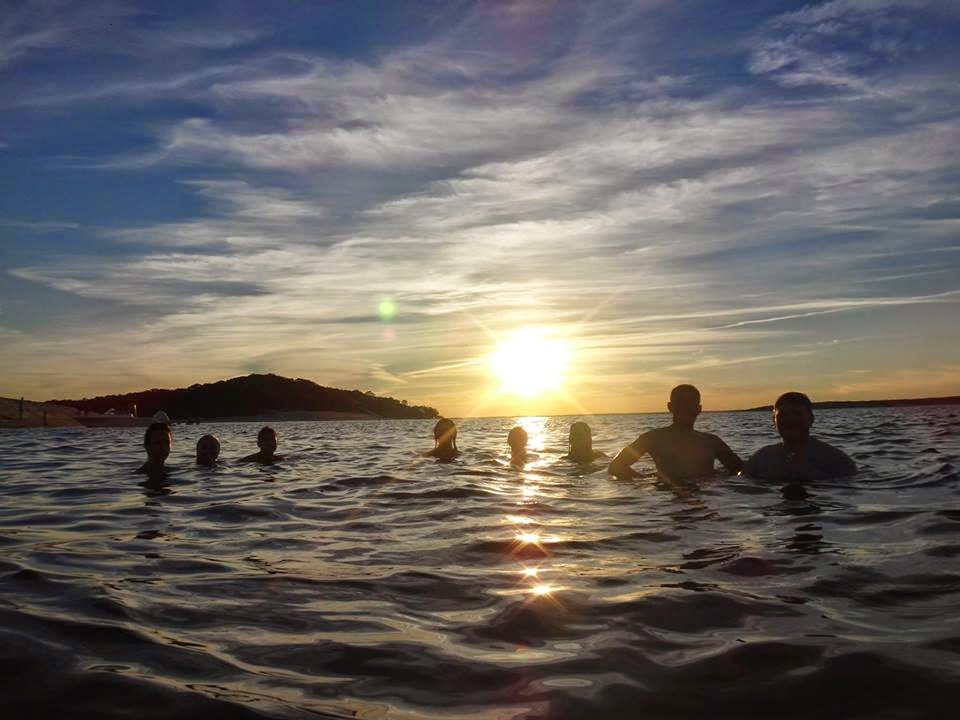 |
|
After eating food we went into the water and a swim and just hung out with each other the sun sets on such a beautiful day.
Photo credit to Kurt.
|
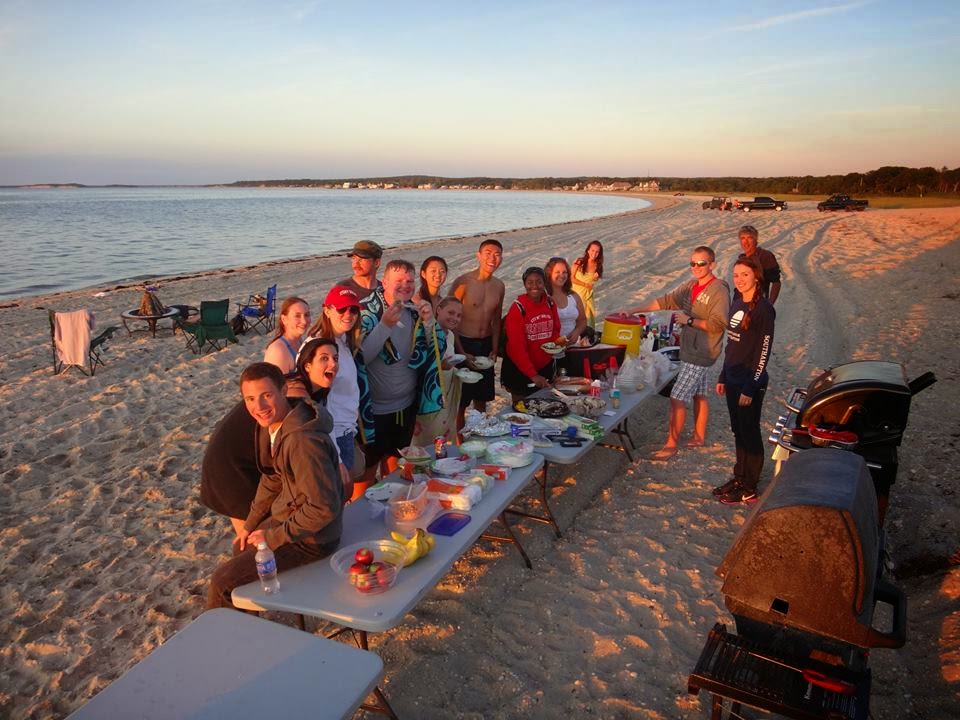 |
|
After 2 hours of kayaking and mini lectures at certain areas around we kayaked to, we had a cook out on the beach. We had seafood, veggies, and fruit!
Photo credit: Kurt
|
When the sun went down, we all crowded around the bonfire for warmth because we just got out of the water and it was a pretty chilly night. Professor Tara told us how sailor would sing shanties so they would constantly breathe when working together to haul or pull things. Tara somehow branched off and talked about the underground railroad in connection with boats and how there might be publications coming out soon about this new connection in history. She stated that Long Island might have been one of the stops because the slaves went up to Canada. Afterwards we sung shanties and a few classmates came up with their own shanties and we all sang along. At around 8:50PM we called it a night for the class and drove back to campus. This trip was by far one of my favorite trip because of the fun we had as well as the fun facts we learned from both Professor Kurt and Tara.
 |
|
What a great way to finish the night by singing shanties around a bonfire! Here we gathered around to warm up after a cold swim in the water.
|
Kayak Trip and Beach Cookout
by Brianna Lusher
 |
|
The new (Mykaela, left) and the old (Libby, Meaghan, and Riley, top to
bottom, on the right) kayakers adjusting to the water.
Photo credit to Meaghan Coyne.
|
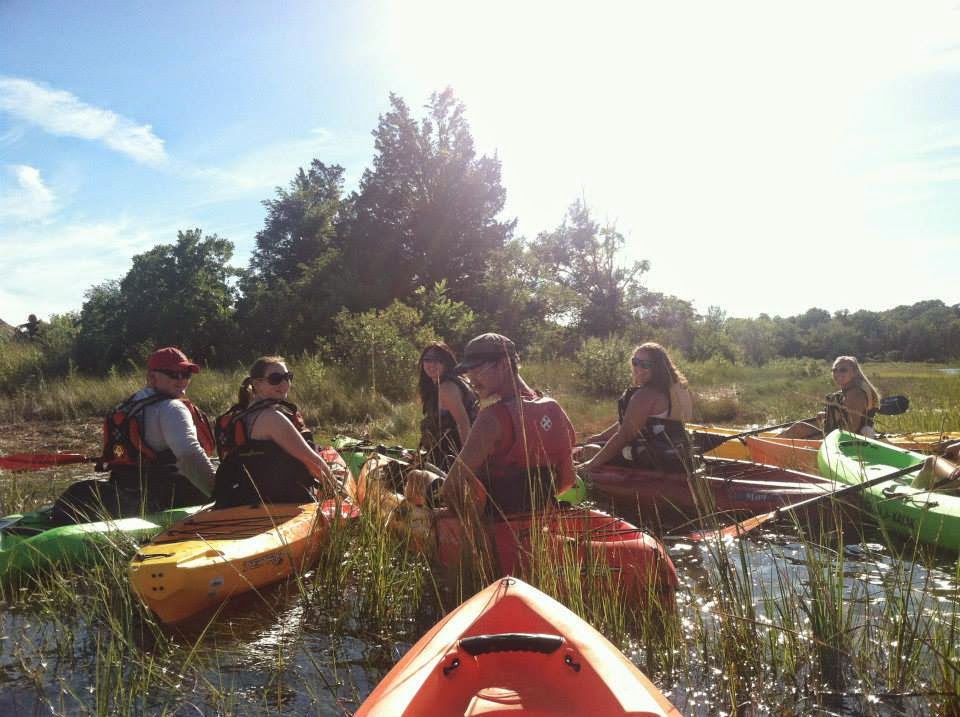 |
|
We have landed at Conscience Point!
(From left to right: Riley, Taryn, Myself, Rob, Becky, and Libby).
Photo credit to Meaghan Coyne.
|
It really was a great day to go kayaking and swimming, then sit around a bonfire with food from a clam bake while singing sailor shanties into the night. This week in Costal Cultural Experiences, even people that have been kayaking before (including myself), learned a few new facts and skills. The kayak rental owner instructed us to not lean your head too far over, or you will tip over, which was something that hadn’t really occurred to me before. Kurt also taught us how to scull, which is a way of paddling parallel to your kayak, allowing you to travel sideways, rather than forwards or backwards. He also mentioned how, if the letters on the paddles of the kayak are upside down, then you are holding the paddle upside down, which I happened to be doing. Even though most of the class had kayaked before, a few got to experience it for the first time, sore arms included.
Tara incorporated a historical aspect about the trip as we kayaked up to a place named Conscience Point. Conscience Point is where a woman decided to get off of a ship that she had been on for about three months, and made the resolution to never go back on the ship again. This was how the European settling of the east end of Long Island came about. It was justly named “Conscience Point,” as her resolution was declared on her conscience.
 |
|
Captain Andy and Brandon, preparing the
seafood, while Taryn, Riley, and Jeanie
(bottom to top) hungrily watch.
Photo credit to Meaghan Coyne.
|
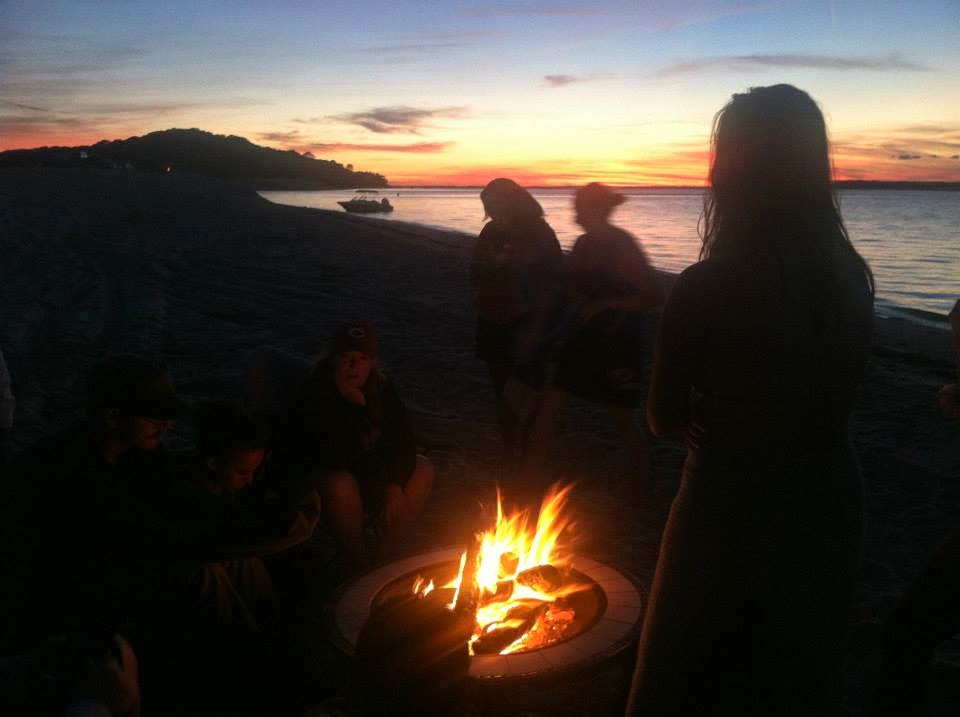 |
|
Nothing like a good sailor shanty around the bonfire as the sun sets!
Photo credit to Meaghan Coyne.
|
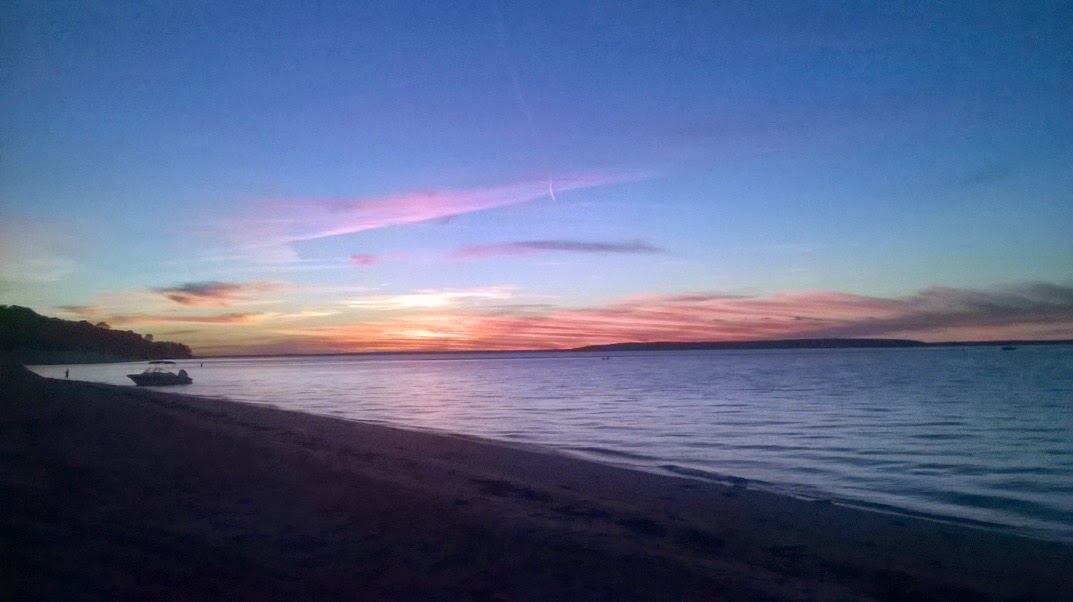 |
|
A perfect sunset to end a beautiful day.
Photo credit to myself.
|
Related














